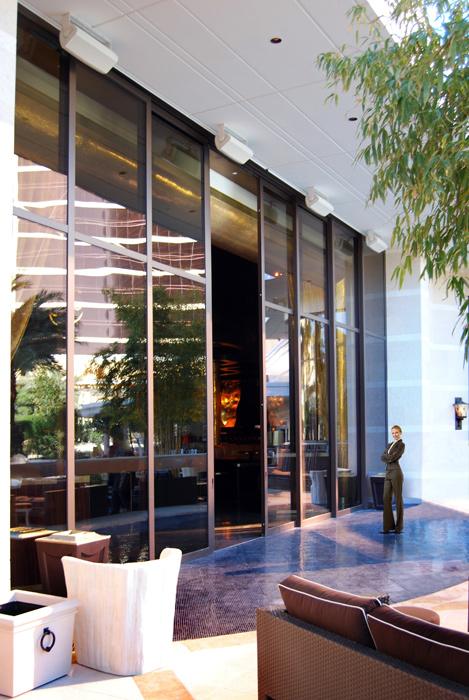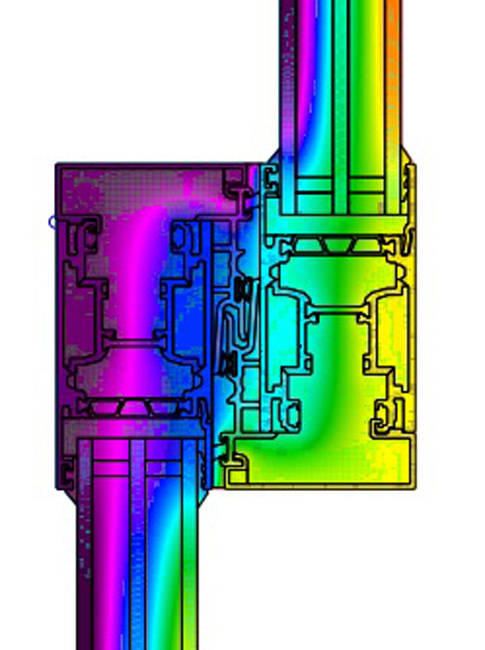Panoramic Glass Door Systems in Green Buildings
High-performance glass doors can provide many benefits for sustainable buildings. They can meet thermal comfort values measurable in ASHRAE standards while providing views to nature and access to daylight. Architects have more flexibility due to the advancement in frames that prevent heat transfer with thermal breaks and glass specified with high insulation values.
Heat transfer through framing in glass walls is called thermal bridging. Thermal bridging is created when materials that are poor thermal insulators come into contact, allowing heat (or cold) to flow through the path of least thermal resistance created. Thermal break insulation is designed to prevent resistance to heat flow by using a material that separates two highly conductive metals such as aluminum. New thermal break products are part of the movement to design high-performance glass openings that can meet sustainable building standards. Ximena Rojas, marketing director at Panda Windows & Doors, says, “Using a thermally broken window or door on a project can assist in enhancing the healthy living environment and sustainability of a project.” She continues, “Thermally broken products can have many environmental benefits; they help improve a building’s energy performance, offer a higher degree of acoustic insulation and have longer service life due to their resistance to the elements.”
The window-to-wall ratio is the ratio of window or opening (glazing) to wall area. It is expressed as a percent. If the window-to-wall ratio is greater than 40 percent, ASHRAE 90.1 provides guidance as to the prescriptive measures necessary to meet the International Building Code. Meeting the code requires designers control both the amount of light in a building as well as the amount of heat loss or gain. The advantages of using integrated building envelopes with attention to the performance of all components mean that the architect can increase the size of glass wall opening systems that also bring high performance benefits.

Photo courtesy of Panda Windows & Doors
The XS Nightclub at the Encore Hotel in Las Vegas, Nevada, has a 41-foot-wide by 20-foot-high opening. The eight panels of the lift and slide doors part in the center of this opening and pocket on each side to open up the club to a large cabana-style pool area.

Source: U.S. Department of Energy

Image courtesy of Panda Windows & Doors
An illustration of the properties of heat flow through an aluminum thermally broken frame.
Design for Climate Zones
Advances in glass opening frame systems have created new products that provide structural stability and flexible design that allow larger operable openings. These systems have higher insulation values and provide thermal barriers to prevent thermal bridging.
Thermal barriers or thermal breaks are included in frames to provide resistance to heat flow. An aluminum thermally broken frame minimizes heat loss from the inside of a building, as well as heat gain from the outside. In the illustration of the high-performance frame shown in this article, the central polyamide iso-bar core material with glass fibers acts as a barrier for heat flow from a warm interior to a cold exterior in winter and vice-versa in summer. The illustration demonstrates how thermally broken frames prevent cold air bridging, restricting airflow from either direction as it "pools" in the middle of the frame. This type of frame construction creates a high level of thermal resistance and utilizes the added benefits of the properties of aluminum such as durability, strength, stability and corrosion resistance.
When designing the components for large openings, the architect will select the correct combination of the orientation of the opening, the glass and frame type necessary to meet the specific project climate zone. There are many advantages to selecting all of the components, the entire window and door package for a large operable door opening system from one manufacturer. These include the following benefits:
• Structural stability
• Superior energy efficiency
• Ease of installation
• Integrated components with warranties that are “all-inclusive” including glass, frames and opening mechanisms
• Factory construction that reduces on-site errors.
Comparing systems requires a true life-cycle analysis that includes not just the initial material costs, but the added benefits of continued energy efficiency, durability and ease of maintenance. One of the biggest mistakes that design teams make is the selection of a non-thermally broken system which becomes a problem in the long run because it is not an appropriate system for the climate in which the project is located.
The following case study is an example of how new technology for massive openings can support the design visions of the 2014 Laureate for the Pritzker Prize, architect Shigeru Ban.









